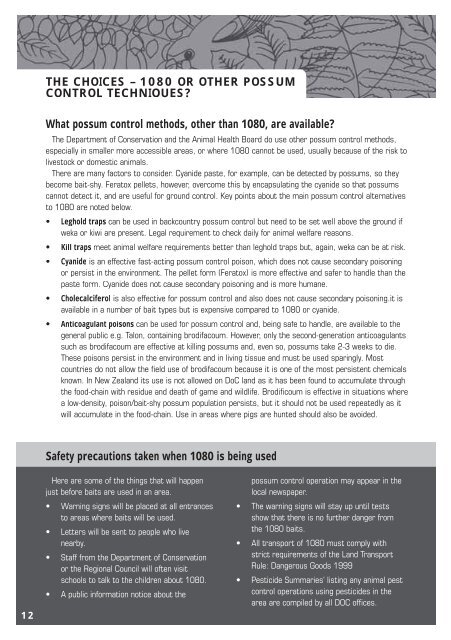National Possum Control Agencies - Department of Conservation
National Possum Control Agencies - Department of Conservation
National Possum Control Agencies - Department of Conservation
You also want an ePaper? Increase the reach of your titles
YUMPU automatically turns print PDFs into web optimized ePapers that Google loves.
12<br />
THE CHOICES – 1080 OR OTHER POSSUM<br />
CONTROL TECHNIQUES?<br />
What possum control methods, other than 1080, are available?<br />
The <strong>Department</strong> <strong>of</strong> <strong>Conservation</strong> and the Animal Health Board do use other possum control methods,<br />
especially in smaller more accessible areas, or where 1080 cannot be used, usually because <strong>of</strong> the risk to<br />
livestock or domestic animals.<br />
There are many factors to consider. Cyanide paste, for example, can be detected by possums, so they<br />
become bait-shy. Feratox pellets, however, overcome this by encapsulating the cyanide so that possums<br />
cannot detect it, and are useful for ground control. Key points about the main possum control alternatives<br />
to 1080 are noted below.<br />
• Leghold traps can be used in backcountry possum control but need to be set well above the ground if<br />
weka or kiwi are present. Legal requirement to check daily for animal welfare reasons.<br />
• Kill traps meet animal welfare requirements better than leghold traps but, again, weka can be at risk.<br />
• Cyanide is an effective fast-acting possum control poison, which does not cause secondary poisoning<br />
or persist in the environment. The pellet form (Feratox) is more effective and safer to handle than the<br />
paste form. Cyanide does not cause secondary poisoning and is more humane.<br />
• Cholecalciferol is also effective for possum control and also does not cause secondary poisoning.it is<br />
available in a number <strong>of</strong> bait types but is expensive compared to 1080 or cyanide.<br />
• Anticoagulant poisons can be used for possum control and, being safe to handle, are available to the<br />
general public e.g. Talon, containing brodifacoum. However, only the second-generation anticoagulants<br />
such as brodifacoum are effective at killing possums and, even so, possums take 2-3 weeks to die.<br />
These poisons persist in the environment and in living tissue and must be used sparingly. Most<br />
countries do not allow the fi eld use <strong>of</strong> brodifacoum because it is one <strong>of</strong> the most persistent chemicals<br />
known. In New Zealand its use is not allowed on DoC land as it has been found to accumulate through<br />
the food-chain with residue and death <strong>of</strong> game and wildlife. Brodifi coum is effective in situations where<br />
a low-density, poison/bait-shy possum population persists, but it should not be used repeatedly as it<br />
will accumulate in the food-chain. Use in areas where pigs are hunted should also be avoided.<br />
Safety precautions taken when 1080 is being used<br />
Here are some <strong>of</strong> the things that will happen<br />
just before baits are used in an area.<br />
• Warning signs will be placed at all entrances<br />
to areas where baits will be used.<br />
• Letters will be sent to people who live<br />
nearby.<br />
• Staff from the <strong>Department</strong> <strong>of</strong> <strong>Conservation</strong><br />
or the Regional Council will <strong>of</strong>ten visit<br />
schools to talk to the children about 1080.<br />
• A public information notice about the<br />
possum control operation may appear in the<br />
local newspaper.<br />
• The warning signs will stay up until tests<br />
show that there is no further danger from<br />
the 1080 baits.<br />
• All transport <strong>of</strong> 1080 must comply with<br />
strict requirements <strong>of</strong> the Land Transport<br />
Rule: Dangerous Goods 1999<br />
• Pesticide Summaries’ listing any animal pest<br />
control operations using pesticides in the<br />
area are compiled by all DOC <strong>of</strong>fi ces.

















